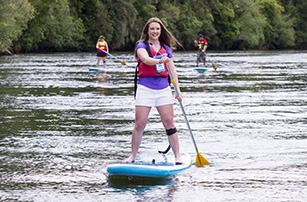Paddle craft
Kayaking
The Waikato region is a sea and fresh water kayaking paradise, but there are some things to keep in mind to stay safe on the water.
Essential requirements for safe paddling
- Before you head out kayaking always know what you might encounter on the way - check out our list of identified river hazards.
- Talk to a local if paddling in a new area - contact the local canoe / kayak retailor or local coastguard unit.
- Take the right equipment including a properly fitting lifejacket, a communications device, a pump, and a sprayskirt.
- Check the weather forecast before heading out.
- Let someone know where you are going and when you will be back.
- Never canoe or kayak alone.
- Make sure you will be clearly visible to other craft on the water.
- Know your limitations.
Paddling at night
Maritime rules require that as a minimum, kayakers must carry a torch to prevent collision. A suitable alternative is a head torch that will allow your arms to be free to paddle. In addition, mounting an all-round white light on your rear deck above head-height means you will be visible from all directions.
Kayak identification requirements
Your kayak must be marked with emergency contact details somewhere on the kayak that is clearly visible.
- You could write with waterproof marker.
- Laminate a card and attach it.
- Write on waterproof tape.
For full information go to clause 5.5 of the Navigation Safety Bylaw.
Stand up paddle boarding
 Stand up paddle boarding is a great way to keep fit while enjoying the region's waterways. Make sure you keep yourself safe by following these simple rules and guidelines.
Stand up paddle boarding is a great way to keep fit while enjoying the region's waterways. Make sure you keep yourself safe by following these simple rules and guidelines.
Rules
- You must wear a lifejacket at all times.
- You must carry at least one form of waterproof communications with you, this could be a phone in a drybag.
Exceptions to the rules:
- Stand up paddle boards in the surf are exempt from carrying communications or carrying a lifejacket (or PFD) as long as they are leashed to the board.
Guidelines
- Consider using a leash, this will keep you and the board together.
- Avoid areas with heavy boat traffic, strong currents, and dangerous outcroppings.
- Keep a safe distance from swimmers.
- Get a lesson from a professional paddleboard instructor or school.
- Always let someone know where you are going and when you'll be back.
- Check the weather and tides before heading out.
- Learn the basics in flat, calm water.
- Stay safe and paddle with a mate.
